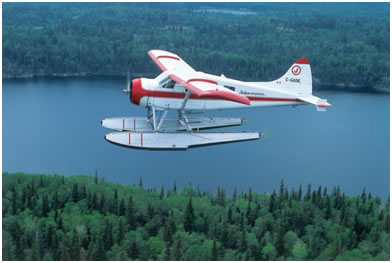
Water-related Aircraft
Regulations under the federal Fisheries Act and Manitoba's Water Protection Act apply to water-related aircraft. Overall, it is illegal to possess AIS, such as zebra mussels and spiny waterflea in Manitoba. In addition, there are AIS import prohibitions and requirements under the federal Aquatic Invasive Species Regulation. Combined, federal and provincial legislation aims at preventing the introduction and spread of AIS.
Water-related aircraft such as float planes can spread aquatic invasive species (AIS). For example, water-related aircraft can harbour AIS such as:
- adult zebra mussels which can attach to submersed water-related equipment or areas of the plane such as the floats/pontoons and rudders.
- tiny spiny waterflea and microscopic larval zebra mussels which can be found inside any space that holds water including inside the floats/pontoons.
Set fines for AIS offences are in effect and apply to water-related aircraft and range from $174 to $2,542 for individuals and higher for corporations.
The aircraft operators' checklist is a helpful resource for operators to comply with the federal and provincial Aquatic Invasive Species (AIS) regulations.

How You Can Help
Immediately before taking off from a water body in Manitoba, the aircraft operator must inspect the water-related aircraft paying special attention to the areas of the plane (floats, cables, rudders) or water-related equipment (ropes) that are in contact or have been in contact with water from the water body. The following are the legal steps, called the general cleaning provisions, for water-related aircraft:
- Immediately before taking off from a water body, the operator of the aircraft must inspect the aircraft's floats or pontoons, cables, wires, ropes and anchors and ensure they are free of:
- aquatic invasive species,
- aquatic plants, and
- mud
A pre-flight walk-around can assist in locating any attached aquatic plants or mud. Float plane operators are advised to lay face-down on the pontoon and run their hands along the pontoon at and below the waterline to thoroughly examine the entire pontoon surface underwater. The pontoons, unless treated with anti-fouling paint should be relatively smooth. Pay special attention to the feeling of the surface of the pontoons or equipment. If the pontoons or water-related equipment feels like sandpaper, this could be small, adult zebra mussels attaching.
The AIS, aquatic plants (such as noticeable build-up of algae or vegetation) and mud must be removed from the aircraft prior to leaving the water body. The pontoons can be cleaned using decontamination methods or removed with an appropriate plastic scraper or scrub brush.
- If water is drained from the float or pontoon of an aircraft, the water must be collected into a container and disposed on land so that it does not drain into a water body.
In addition, more strict measures are in place where AIS, such as zebra mussels have established. These areas are called control zones. Control zones are areas in which AIS have been found or are expected to spread. The stricter measures pertaining to control zones are in addition to the general cleaning provisions and they apply to watercraft, ORVs and water-related aircraft being removed from control zones.
Aircraft cannot be moored in the Central Control Zone the Nelson River Control Zone or the Saskatchewan River/Cedar Lake Control Zone for longer than 12 hours unless the aircraft’s floats or pontoons are treated with anti-fouling paint maintained in good condition. For a control zone map, please click here.
Anti-fouling paint is paint treated with biocides or other products intended to prevent the attachment or slow the growth of organisms. Note: Anti-fouling paint must state on the label the paint is to prevent attachment of zebra mussels. Also, antifouling paint not approved by Health Canada cannot legally be used in Canada.
Health Canada’s Pest Management Regulatory Agency regulates the use of anti-fouling paint for use in Canada. For more information, visit http://www.hc-sc.gc.ca/cps-spc/pest/index-eng.php.
The Water-related Aircraft Checklist is a step-by-step resource that can help you comply with the Manitoba government’s AIS Regulation. The checklist can be found here.

